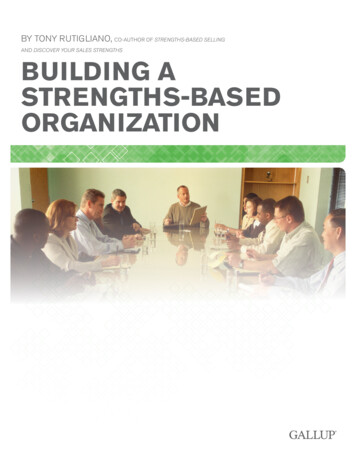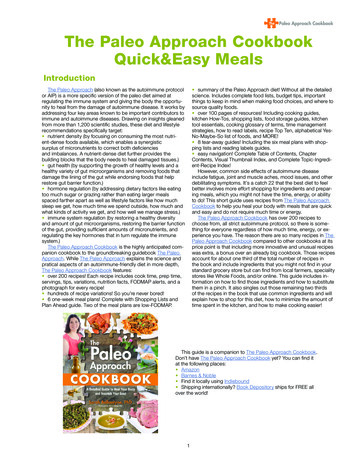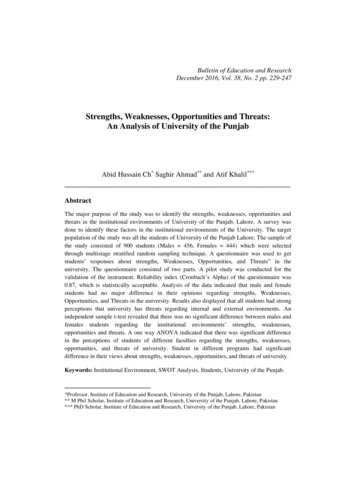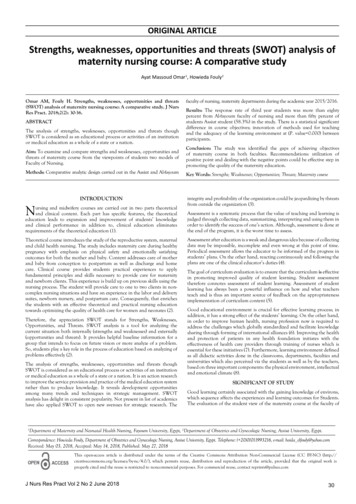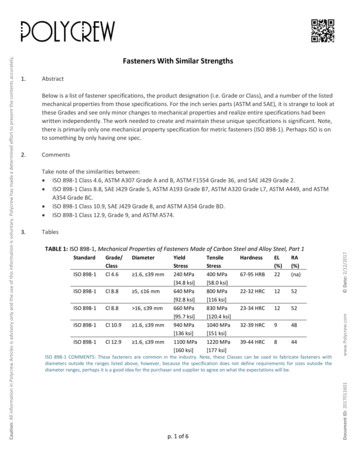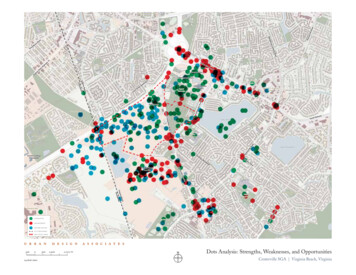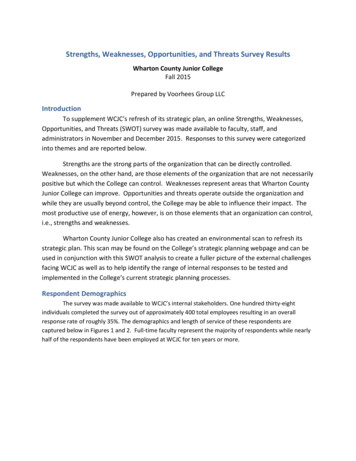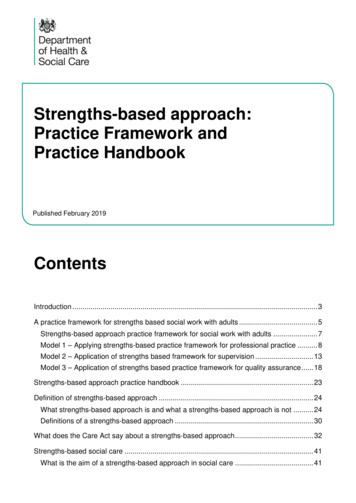
Transcription
Strengths-based approach:Practice Framework andPractice HandbookPublished February 2019ContentsIntroduction . 3A practice framework for strengths based social work with adults . 5Strengths-based approach practice framework for social work with adults . 7Model 1 – Applying strengths-based practice framework for professional practice . 8Model 2 – Application of strengths based framework for supervision . 13Model 3 – Application of strengths based practice framework for quality assurance . 18Strengths-based approach practice handbook . 23Definition of strengths-based approach . 24What strengths-based approach is and what a strengths-based approach is not . 24Definitions of a strengths-based approach . 30What does the Care Act say about a strengths-based approach . 32Strengths-based social care . 41What is the aim of a strengths-based approach in social care . 41
Strengths-based approach practice frameworkThe assessment process within a strengths-based approach . 42Enablers to a strengths-based approach . 50What is needed to enable a strengths-based approach? . 50What are the key skills for strengths-based conversations? . 58Examples of strengths-based interventions; applying the KcVETS model . 60Supervision . 60Assessment in the community: Arpita's story . 65Review in a residential placement: Ant’s story . 69Rehabilitation in a Mental Health placement: Jonno’s story . 75Re-assessment at home: Jane’s story. 79Safeguarding investigation: Mary’s story . 85Youth offending assessment: Daniel’s story . 89Preparing for adulthood assessment: Richard’s story . 97Appendix – useful links and resources . 1022
Strengths-based approach practice frameworkIntroductionIn January 2017 the Chief Social Worker for Adults in collaboration with the Social CareInstitute for Excellence (SICE) hosted a round table event at SCIE to explore whatstrengths-based social work with adults, individuals, families and communities reallymeans for practitioners and people using services. The event brought togetherprofessionals, researches and experts by experience to share examples of good practiceand the challenges of working in a strengths-based way.One of the next steps identified was to ‘build on the enthusiasm and output from the eventand take forward the development of a practice framework and supporting guidance’.Factors such as organisational context, structure and mandate, access to resources,legislation, theoretical cultures and professional knowledge influence and have thepotential to shape professional practice for social workers working with vulnerable adults,families and communities. Personal identity, culture and background also play a role ininfluencing the way we think and what we do (Connolly 2007).Practice frameworks are well regarded and understood as methods to drive forwardeffective professional practice in social work and human services (Connolly, 2007; Stanley2016; 2017). They provide schematic templates for systematically improving practiceanalysis initially for assessment and interventions and also helping practice reform(Connolly 2007; Healy 2005; Stanley, 2016). Connolly (2007) made the point that there isa “tendency to use models, paradigms and frameworks for practice interchangeably,” thusgetting the language right is important.Practice frameworks are therefore a schematic template not based on or informed byorganisational imperatives but designed through and informed by value-based practice,research and evidence. A practice framework offers a mapping out of what we do andwhy, offering a rationale for practice, while promoting a range of practice tools forassessments and interventions.A practice framework ‘integrates empirical research, practice theories, ethical principlesand experiential knowledge in a compact and convenient format that helps practitioners touse the knowledge and principles to inform their everyday work’ (Connolly and Healy2009, p32).This publication includes development of a practice framework for strengths-based socialwork with adults. The framework is supported by a practice handbook which outlines whatis a strengths-based approach, its legislative context, the necessary skills and the enablersfor it to be implemented. The handbook also has a range of examples of strengths-basedinterventions, with reflection on why they are strengths-based and how the practice3
Strengths-based approach practice frameworkframework can be applied to them, in addition to providing useful resources and links forpractitioners.4
Strengths-based approach practice frameworkA practice framework for strengthsbased social work with adultsPractice frameworks provide a guide to undertaking humane and morally informedassessment and intervention work, and, offer practitioners an intervention approach andlogic that is theoretically based and supported by a set of practice triggers. According toStanley (2016; 2017), an agreed framework needs to reinforce ideas of up to date practiceand co-produced knowledge (Kc) and research, promote our social work values (V) andethics, render visible social work theories (T) and methods, and promote a range ofpractice skills (S). The practitioner’s experiential learning is also recognised (E) andpromoted and this is important if we are to avoid prescription and promote professionaljudgement and professional decision making.This handbook, introduces a practice framework for strengths based practice for socialwork with adults. It is based on a five quadrant model promoted as a set of practicetriggers or prompts bought to action through knowledge, values, experiential learning,theories and skills – KcVETS. Within each domain we have used the ‘art of the goodquestion’ approach to highlighting and emphasizing the core KcVETS required to practicea strengths based approach to social work with adults.To be truly effective, a practice framework must also be reflected in supervision processes,quality assurance systems and importantly modelled throughout the organisationparticularly by managers and leaders. Quality assurance should be an active considerationof purpose, including the activities of practice, as well as considering the skill andexperience of the worker involved. Good social work helps to guide change and is anintellectual activity and moral endeavour and quality assurance needs to focusaccordingly. Utilising this model in supervision and asking the right quality assurancequestions from this perspective, will involve qualitative alongside quantitative measures.Lyn Romeo, England’s Chief Social Worker for Adults (England) explains why this isnecessary:Social workers should have a critical understanding of the difference between theory,research, evidence and expertise and the role of professional judgement. They should usepractice evidence and research to inform the complex judgements and decisions neededto support, empower and protect their service users. They should apply imagination,creativity and curiosity to working in partnership with individuals and their carers,acknowledging the centrality of people’s own expertise about their experience and needs(Chief Social Worker, Department of Health, 2015)5
Strengths-based approach practice frameworkThe KcVETS practice framework promotes active exploration. Hypothesising, questioningand reflecting on how I work and what we create through our work together helps shiftpractice toward a more resourceful, open, helpful approach, conducive to promoting socialjustice and human rights as core social work activities. This is the systemic practiceneeded by frontline social workers and the most senior of leaders (Burnham, 2010) –hence success in practice and systems reform requires every level of the organisation tounderstand and invest in systemic ideas and practice methods, both intellectually andmorally (Stanley and Kelly, 2018).The Practice Framework is three fold; to engage, reform and pivotally enhance social workpractice, reform of practice must also include reform of the system.We have developed a Practice Framework designed to enhance professional practice,facilitate meaningful supervision reflecting the five quadrants and importantly developed aquality assurance/audit framework which again promotes the professional practiceframework and the supervisory framework. We have attempted to create a 'double loop'process of learning, development, professional practice which is reinforced, supported anddriven by organisational systems and processes and individuals operating within thesesystems.Professor Samantha BaronDr Tony Stanley6
Strengths-based approach practice frameworkStrengths-based approach practice frameworkfor social work with adultsGraphic 1 - KcVETS model7
Strengths-based approach practice frameworkModel 1 – Applying strengths-based practice framework forprofessional practice8
Strengths-based approach practice frameworkGraphic 2 - Knowledge and Co-creation in model 1Graphic 3 - Values and Ethics in model 19
Strengths-based approach practice frameworkGraphic 4 - Experiential learning in model 110
Strengths-based approach practice frameworkGraphic 5 - Theories and Methods in model 111
Strengths-based approach practice frameworkGraphic 6 - Skills in model 112
Strengths-based approach practice frameworkModel 2 – Application of strengths based framework for supervisionGraphic 7 - Knowledge and Co-creation in model 213
Strengths-based approach practice frameworkGraphic 8 - Values and ethics in model 214
Strengths-based approach practice frameworkGraphic 9 - Experiential learning in model 215
Strengths-based approach practice frameworkGraphic 10 - Theories and methods in model 216
Strengths-based approach practice frameworkGraphic 11 - Skills in model 217
Strengths-based approach practice frameworkModel 3 – Application of strengths based practice framework forquality assuranceGraphic 12 - Knowledge and co-creation in model 318
Strengths-based approach practice frameworkGraphic 13 - Values and ethics in model 319
Strengths-based approach practice frameworkGraphic 14 - Experiential Learning in model 320
Strengths-based approach practice frameworkGraphic 15 - Theories and methods in model 321
Strengths-based approach practice frameworkGraphic 16 - Skills in model 322
Strengths-based approach practice frameworkStrengths-based approach practicehandbookThis practice handbook complements the practice framework in supporting social workersand social care professionals in the application of strengths-based practice and theKcVETS model.In developing this resource, we found that many social workers and social careprofessionals we met fundamentally supported a strengths-based approach within adultsocial work and social care but often found it difficult to demonstrate, evidence andpractice such an approach in practice. We hope that the handbook will be a helpfulprompt and guide that practitioners can refer to as they continue to practice strengthsbased social work and social care. We have incorporated clear case examples thatdemonstrate how the approach can be utilised across a variety of settings andinterventions.We envisage that his practice handbook can be used individually or in groups, insupervision or team meetings, to support the understanding and implementation of astrengths-based approach to social work and social care.As the main legislative framework for social care and social work with adults, The Care Act2014 is referenced throughout the handbook to provide context to the legal duties thatapply to social work and social care practice and how a strengths-based approach alignsto those duties.The handbook aims to shift the focus from finding one specific “Key Model” to one offlexible relationship-based working which underpins strengths-based practice. In addition,we are hoping to demonstrate a ‘life span’ where the determination of the model, tool ortechnique to use is based on the specific circumstances of the intervention and theindividual at the focus of the intervention, and therefore different each time.Written by Carmen Colomina and Tricia Pereira.23
Strengths-based approach practice frameworkDefinition of strengths-basedapproach‘Excellent social work is about emphasising the use of professional engagement andjudgement, as opposed to procedural approaches, with a focus on the individual, taking aholistic and co-productive approach to keeping the person at the centre of all decisions,identifying what matters to them and how best outcomes can be achieved. It is aboutenabling people to find the best solutions for themselves, to support them in makingindependent decisions about how they live. I whole heartedly believe in taking a strengthsand asset based approach to supporting individuals and empower people to live the livesthey want.’Lyn RomeoWhat strengths-based approach is and what astrengths-based approach is notMuch has been said about strengths-based approaches, asset-based approaches andstrengths-based practice and how it applies to working with individuals, families andcommunities. Some of the information can be confusing and this guide aims to helpidentify and provide examples of what is considered positive strengths based approachand what a strengths based approach is not.Strengths-based practice is holistic and multidisciplinary. Over time, we have seen howcare management approaches have predominantly focused on a deficit model, forexample with questioning such as what are the problems and Issues the individual isexperiencing? What are they unable to do and how can we solve this? We know this hasshaped professional social work and social care practice in a certain way and a strengthsbased approach challenges this deficit model.A strengths-based approach explores, in a collaborative way the entire individual's abilitiesand their circumstances rather than making the deficit the focus of the intervention. Weshould gather a holistic picture of the individual’s life; therefore it is important to engageand work with others (i.e. health professionals, providers, the individual's own network, etc.with appropriate consent).Strengths-based practice is applicable to any client group, to any intervention and can beapplied by any profession.24
Strengths-based approach practice frameworkWhen using a strengths-based approach, risk is looked at as an enabler, not as a barrier.Risks should be explored with the individual and from their point of view. The role of theprofessional is not solely to ‘reduce risks’ but to support the individual in managing risks.This can be done by: identifying all the potential benefits and potential risks of a particular activity ordecision for the individual and others, exploring and fully understanding the consequences of both the potential benefitsand the potential risks for them and others collaboratively, identifying the best way to manage the identified risks, maximisingthe benefits and if appropriate reducing the potential negative consequencesThe aim should not be about risks or benefits for the organisation that the practitionerworks in or for the practitioner them-self, but about benefits and risks for the individual andothers.There are many models, tools and techniques to apply a strengths-based approach tosocial work and social care interventions, but the key thing is to ensure that whichever onewe use it is appropriate and proportionate for the intervention and the circumstances of theindividual.One fundamental point of a strengths-based approach is that it is an ‘approach’, not anoutcome or a process. It is less about ‘what the end result is’, or ‘what we do’, and moreabout ‘how we do things' It is about being aware of the skills we use when we approachindividuals, their families and the community to address a particular situation. The aim is toenable better outcomes and/or lives for people, and we should be mindful that noteverything that provides better outcomes for individuals is a strengths-based approach.Therefore, it is important to clarify that ‘reduction of packages of support’, is generally acollateral benefit of a strengths-based approach. A reduction in provision of services,should not be the outcome we are seeking, and this is not what the application of astrengths-based approach is.Working from a strengths-based position, is not about 'giving people less support andservices', but working with people to identify together, the best next- step for them utilisingall the strengths and resources they currently have or may have access to. Moreover,working in this way is not about ‘not providing help’, but, rather it is about ensuring that aspractitioners we are providing the right help, advice, and support at the right time.There are occasions when carers have felt coerced into providing more help than they canprovide, what in some situations have meant a detriment to their own wellbeing. Whenhaving strengths-based conversations the social worker or social care professional should25
Strengths-based approach practice frameworkdiscuss with the individual and their carers what the next best step is for all concerned,and sometimes this is not necessarily promoting independence or being more sociable,but always should be promoting their -individual and carer- wellbeing.The individual should be clearly at the heart of any intervention. Their views should becentral; it is not helpful to carry out interventions where the individual is a passive elementin the dynamic. A strengths-based approach is person centred and therefore ensures thatthe intervention is about the individual and their life and circumstances.Some quotes from carers:"Too much is online, people need personal contact, a warm handshake and a hello. Socialworkers - People in people's homes, that hold your hand when your loved one is dying,that what we want, that’s what matters" . John in response to being informed he cancomplete an online self-assessment."I couldn’t see straight, I was so enmeshed in it all, in caring for my wife and watching herdie. It was a 7-year bereavement, the social worker helped me see things more clearly,they helped me to plan" – Bob 84" I want consistency, if possible, I want to see the same social worker again who can alsotalk with and share information with other professionals. I don’t want a new person everytime so that I have to repeat myself and go over my history, I want someone that knowsme, I want to build that rapport. I don’t want just anyone in and out of the home, its soconfusing for my husband" . Barbara"I didn’t choose to be a carer, it wasn’t a choice. But you chose to be a social worker andyour training helps you to deal with situations like this. Your skills are to listen and to delvedeeper and to say, I understand". - EdwardAs professionals it is usual for our knowledge to inform our approaches to how we workand engage with others. However, the individual should be supported to acknowledge andshare how their 'disability, impairment or illness, situation' impacts them as an individual.We should avoid identifying a problem, and then provide a solution based solely on ourknowledge, without taking into account the individual, their ambitions, their circumstances,their network, etc. We should be considering how their life is impacted by the ‘disability,impairment or illness’, in a way that discourages passivity and dependence.What can be helpful is to provide the right support, advice and guidance so that peoplecan retain or regain their independence and resilience.26
Strengths-based approach practice frameworkThe individual should play an active part in any intervention, and the focus should be theindividual’s life; what it is about, what they would like it to be, and how, whatever ishappening to them is having an impact on their lives.Proportionality is important in any social care intervention, the Care Act 2014 amongstother legislations emphasises the importance and the duty of ensuring that interventionsby professionals working in the public sector are proportionate to the circumstances. Thereisn’t ‘one way’ of having a strengths-based approach – any intervention can have elementsof it depending on the context, constraints, etc.There are occasions when they can’t participate in the conversation as fully as it isdesirable. For example the individual may ‘lack capacity’, may be ‘overwhelmed by thecircumstances’, ‘may lack insight into their problems’, or ‘may have cognitive problems thatpose a barrier to their understanding and communication skills’. In all these cases, thesocial worker or social care practitioner should look at what is getting in the way of theindividual to ‘fully participate’ and take the necessary steps to overcome as many barriersas possible.Professionals must ensure that all the appropriate and necessary tools (i.e. independentadvocates, mental capacity, specific times or locations, communication aids, short visits,other professionals, etc.) are used to maximise the involvement of the individual in theprocess and their ability to engage in the conversation.Graphic 17 - Person Centred and strengths-based approach27
Strengths-based approach practice frameworkThe Care Act places into local authorities the duty to ‘maximise the individual involvementin the process’ – the process being the intervention. To facilitate this the Care Act detailsthat if the individual has ‘substantial difficulty' in being engaged in the process, the localauthority should commission an independent advocate to facilitate this engagement.The Care Act also explains that if there is an ‘appropriate person’ (see criteria in the CareAct 2014), the local authority does not have to commission an independent advocate. Fora friend or family member to be an ‘appropriate person’, amongst other things, they haveto have the skills and ability to maximise the individual involvement in the process, notpurely to act on their behalf.Social workers and social care professionals must have expert communication skills, andthe ability to identify and apply the most appropriate communication mean, or acombination of means for each individual and intervention, with the necessary flexibilitythat each intervention requires.Professionals should have meaningful, collaborative conversations where their skills andknowledge help the individual to identify their strengths, needs, desired outcomes,resources, potentialities and solutions to co-produce a way to maximise the individual’squality of life.Social workers and social care professionals must build a trusting relationship with theindividual where they can show empathy whilst maintaining the necessary professionalobjectivity. It is not about providing ‘made up solutions’ or ‘fixing’ problems/deficits, butenabling people to live the lives they want to lead. This cannot be done in a prescriptive orrigid way because individuals and their circumstances are different (i.e. have differentstrengths, networks, resources, desires, etc.) even if affected by the same ‘disability,impairment or illness’.It isn’t about services either; it is about meaningful lives, it is about the individual and theirsocial and family networks and their communities and how all of them link togethermaximising outcomes for individuals.Community social work and community development are fundamental in strengths-basedapproaches.We frequently talk about 'empowering' individuals. The Cambridge dictionary definesempowerment as 'to give someone official authority or the freedom to do something'. Wethink it is a bit arrogant to believe that we have the ability to give people power. We insteadshould be helping people find the power within themselves, providing them with tools tofind their own power.28
Strengths-based approach practice frameworkGraphic 18 - Summary of what strengths-based practice isGraphic 19 - Summary of what strengths-based practice is not29
Strengths-based approach practice frameworkDefinitions of a strengths-based approachThere are many definitions of what strengths-based approach is. We are not attempting togive a comprehensive reference to all, and have selected a handful that captures all thekey core elements of strengths-based approach.A strengths-based approach to care, support and inclusion says let’s lookfirst at what people can do with their skills and their resources – and whatcan the people around them do in their relationships and theircommunities. People need to be seen as more than just their care needs –they need to be experts and in charge of their own lives.’(Alex Fox, CEO Shared Lives)Working in a collaborative way promotes the opportunity for individuals tobe co-producers of services and support rather than solely consumers ofthose services.Morgan and Ziglio, 2007)Strength-based practice is a social work practice theory that emphasisespeople's self-determination and strengths. It is a philosophy and a way ofviewing clients as resourceful and resilient in the face of adversity. It is client-led, with a focus on future outcomes and strengths that people bringto a problem or crisis. When applied beyond the field of social work, strength-based practice is alsoreferred to as the "strengths-based approach".(McCashen Wayne (2005)30
Strengths-based approach practice framework‘Strengths-based practice is a collaborative process between the personsupported by services and those supporting them, allowing them to worktogether to determine an outcome that draws on the person’s strengthsand assets. As such, it concerns itself principally with the quality of therelationship that develops between those providing and being supported,as well as the elements that the person seeking support brings to theprocess’.(Duncan and Hubble, 2000)Graphic 20 - Key elements of strengths-based approach31
Strengths-based approach practice frameworkWhat does the Care Act say about astrengths-based approachThe Care Act 2014 does not specifically give local authorities the duty to use a strengthsbased approach in their practice as such. It does however establish that they must orshould perform their care and support functions in a particular way that is not dissimilar to,and incorporates the core elements of a strengths-based approach.The ‘wellbeing principle’ and the core duty of ‘promoting individual wellbeing’ placed inlocal authorities exercising any care and support functions, emphasises the importance ofworking in a holistic way with the individual. Hence the description of ‘wellbeing’ detailingthe nine areas that must be taken into account to consider individual wellbeing.The duty to promote individual wellbeing applies to any care and support function carriedout by the local authority (i.e. any member of staff working for the local authority). It doesnot apply only to individuals who have been identified as having eligible needs, but to allindividuals living in the local authority area.Please note that the quotes in this section are verbatim from the Care Act statutoryguidance, we also include the reference to the paragraph in the guidance (i.e. 1.2) with theexception of the bolding of some text.1.2 Local authorities must promote wellbeing when carrying out any oftheir care and support functions in respect of a person. This maysometimes be referred to as ‘the wellbeing principle’ because it is aguiding principle that puts wellbeing at the heart of care and support.1.3 The wellbeing principle applies in all cases where a local authority iscarrying out a care and support function, or making a decision, in relationto a person. For this reason it is referred to throughout this guidance. Itapplies equally to adults with care and support needs and their carers.The concept of wellbeing in the Care Act is broader than the areas covered by the‘eligibility outcomes’, hence why all interventions – care and support functions – should32
Strengths-based approach practice frameworkaddress the nine areas of the individual wellbeing and not the nine or ten areas within theeligibility outcomes.The aim of promoting individual wellbeing is to ensure that individuals have meaningfullives – the focus should not be only to meet eligible needs.‘A life worth living until I die’People with life experience at the ‘strengths-based social work practice with adults’ roundtableTo ensure that we are aware of what is meaningful for the individual, we have to havemeaningful conversations about them, their lives, their hopes, their strengths, theirpriorities, and on the way identify
social work and social care but often found it difficult to demonstrate, evidence and practice such an approach in practice. We hope that the handbook will be a helpful prompt and guide that practitioners can refer to as they continue to practice strengths-based social work and social

